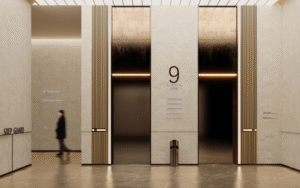Hamish Kilburn, Editor of Hotel Designs and the host of Travel By Design, a podcast by Marriott Bonvoy Traveler, spoke to renowned designer and architect David Rockwell about the new design narrative of W New York – Union Square, which he originally conceived 23 years ago…

It is the ultimate compliment for a designer or architect; to be invited back on the project they originally created and asked to transform it into its next chapter. For David Rockwell, the praise was personal when he was asked back to redesign W New York – Union Square, as the area has been the home of his studio since the ‘80s.
On the podcast, Travel By Design, by Marriott Bonvoy Traveler, I spoke to the designer to grasp the significance of transforming the hotel, which he originally designed in 2000. I wanted to know how the hotel would look and, more importantly, feel different. In addition, I wanted to understand how Rockwell has seen the area of Union Square develop over the years, and what, if anything, was different when it came to his inspiration on the milestone project.
Before understanding the design of today’s hotel, I first had to learn about what the destination was like when he first started working on the project. “At that time, Union Square was being used for a kind of beautiful green space; it’s the destination at the end of Broadway, so it’s a seminal place geographically in New York,” Rockwell told me. “The building is a phenomenal landmark building, built in 1911. And fashion was focused in this neighbourhood.

Image caption: Rockwell Group were asked to redesign W New York – Union Square, the same hotel the studio originally designed in 2000. | Image credit: Marriott International
“But [from then to now], it has become a place that more replicates what it was historically. Originally, Union Square was a place for celebrations, for protests, and I feel like it has become, now, so much more fluid.”
Guests will only have to enter the lobby area to appreciate the scale of its transformation. Prior to the recent design shift, a large welcome desk underneath a staircase dominated the room. It was very much, on the surface, a conventional check-in experience.
Now, the space have been somewhat softened – it is less angular – and everything feels more fluid. It’s as if the shoulders of the hotel have relaxed and it is ready to have a conversation with its guests. “Well, that’s absolutely true,” Rockwell added, “because, in fact, it’s a much more explosive use of colour and form. When we started the hotel, we knew we wanted that staircase to be a central, featured, dynamic element.”

Image caption: The F&B scene inside the hotel is about ‘giving the space back’ to the local community. | Image credit: Marriott International
Rockwell and his team have played with boundaries and volume in the public areas. A runner from the stairs, now spills into lobby, which draws guests’ attention towards the architectural structure of the building, and invites people to look up and around. “So, it really is like a kind of river that moves up, with the carpet flowing down, and then the carpet and the banister and the flowers really feel like almost a gravitational spill down to the ground, to pull you up,” commented Rockwell.
Aside from the initial welcoming experience, the overall public area inside the hotel has been, in Rockwell’s words, “given back” to the community. And that, in its simplest form, is how I would best describe the new design inside W New York – Union Square; accessible, dynamic and, just like the square its perched on, a thriving social hub that is forever evolving in time.

Image caption: The interior design scheme of the room is noticeably softer, with more of a luxury feel. | Image credit: Marriott International
> Since you’re here, why not listen and read about St Regis Kanai, which was also featured on this series of the podcast?
The full 13-minute interview between David Rockwell and Hamish Kilburn on Travel By Design dives into the original creative approach of the hotel as well as another project that Rockwell created with the help of a choreographer.
Main image credit: Marriott International






















